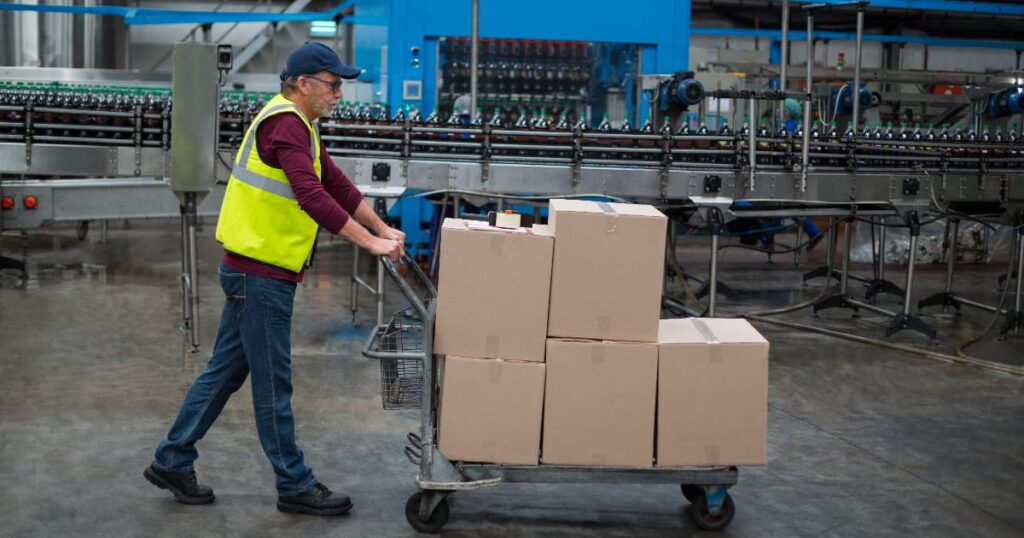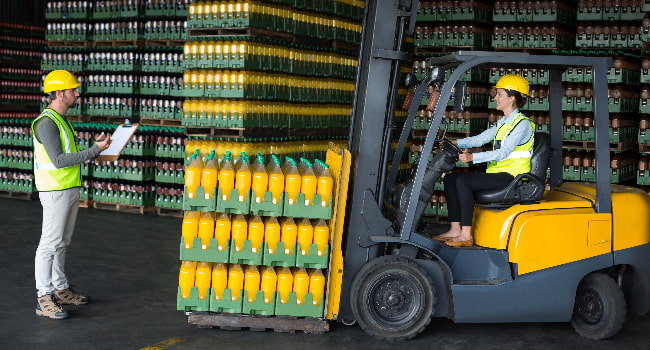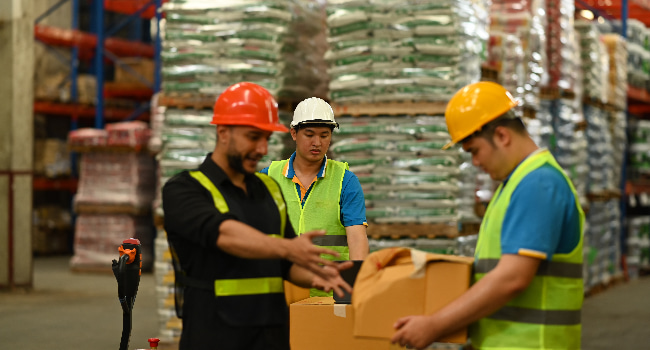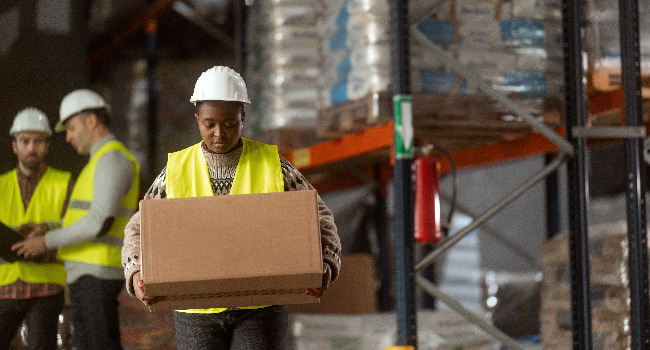A1 Quality Logistical Solutions

- By Haley
- February 13, 2025
Table of Contents
Key Highlights
- Lumping services play a vital role in the food and beverage industry by ensuring efficient loading and unloading of goods, directly impacting supply chain fluidity.
- Choosing the right lumping partner can significantly optimize warehouse operations, leading to improved inventory management and order fulfillment.
- When evaluating potential lumping service providers, key considerations include experience in the food and beverage sector, cost structure, and adherence to industry-specific health and safety regulations.
- Integrating lumping services strategically can address challenges related to regulatory compliance and cost management, ensuring smoother distribution processes.
- The future of lumping services is expected to be shaped by technological advancements and evolving trends, pushing the industry towards greater efficiency and transparency.
Introduction
Within the food and beverage sector, a smooth-running supply chain helps keep products fresh, meet customer needs, and make customers happy. This complex system depends on efficient distribution services. Among these, lumping services play an important role. They make the hard work of loading and unloading easier. This helps improve how well food and beverage supply chains run.
Understanding Lumping Services in the Food and Beverage Industry
Lumping services are especially important in the food and beverage sector. Here, getting products delivered on time and keeping them safe is required due to expiration dates. In a business with lots of products that can be sensitive, lumping services are more than just loading and unloading items. They help improve warehouse operations and keep goods moving smoothly in the distribution chain.
Simply put, lumping services mean using special workers called lumpers. They take care of moving goods inside a warehouse or distribution center. This includes unloading items from trucks, organizing and storing the items, and then loading them onto other vehicles for delivery. Using lumping services in this systematic way can greatly help improve supply chain efficiency.

Defining Lumping Services and Their Role
Lumping services focus on moving shipments in warehouses or distribution centers. In the food and beverage industry, lumpers handle pallets of perishable items, drinks, and raw materials. This requires careful handling and strong hygiene practices.
Lumping is more than just physical work. It plays a big role in supply chain management. When lumping is done well, it helps speed up the loading and unloading processes. This leads to faster truck turnaround times and less time products spend waiting, which is really important for keeping food and drinks safe and fresh.
Also, lumping services help make good use of space in a warehouse. A smart lumping plan helps keep products organized, allowing for better inventory control. This is very important in the food and beverage sector, where different products might need different storage conditions, like temperature control.
The Importance of Lumping Services in Supply Chain Efficiency
In the food and beverage business, lumpers must deal with products that can spoil. In this field, the speed and reliability of transportation services matter a lot. Lumping makes sure that loading and unloading happen quickly and correctly. This limits delays and keeps goods in transport for as little time as possible.
Lumping services also help with inventory management. The organized ways of unloading and storing goods make it easier to track inventory accurately. When errors are reduced and goods are easy to find, it helps avoid running out of products. This lowers the chance of spoilage and makes order fulfillment smoother, which is crucial in the food and beverage industry.
Additionally, lumping helps use warehouse space effectively. Good storage leads to lower warehouse costs and can mean that extra storage space isn’t needed. This positively affects a business’s overall profits.
The Benefits of Utilizing Professional Lumpers
Using professional lumping services has many benefits. First, these experts know how to manage warehousing and distribution well. They are trained to load and unload different types of goods safely. This is particularly important for fragile food and drink items.
Additionally, hiring professional lumpers allows businesses to focus on what they do best. By letting specialized teams handle the heavy work of loading and unloading, companies can use their workers more effectively. This can lead to higher productivity and may help lower labor costs over time.

Enhancing Loading and Unloading Efficiency
One of the main benefits of hiring professional lumpers is that they make loading and unloading much faster. These trained workers are quick and organized. They help get trucks loaded and unloaded in less time, which means drivers do not have to wait long. This improves the use of transportation resources.
Also, professional lumpers know how to operate warehouse tools, like forklifts and pallet jacks. This helps goods move around the warehouse more easily. They are experienced in handling the layout of the warehouse and know how to stack items safely and efficiently.
The efficiency continues to improve when lumping services work with a good warehouse management system (WMS). A WMS gives information about inventory levels and item locations. This helps lumpers plan their tasks and find items faster. When skilled workers and technology work together, the process in the warehouse becomes more efficient.
Reducing Risk and Improving Safety in Operations
Safety is a concern in warehouses, regardless of the industry. Trained professionals called lumpers know safety rules and the best ways to handle goods. They help to lower the chances of accidents, damage to products, and injuries in the workplace.
Lumpers receive proper training to spot dangers, use safe lifting methods, and handle safety gear correctly. This focus on safety keeps the workplace safe. It protects valuable items and also creates a good working environment. It can help businesses avoid legal trouble.
Also, reliable lumping service providers follow industry rules. They pay attention to food safety, cleanliness, and workplace safety. This level of care means businesses can be confident that they meet important guidelines. It helps reduce the chance of penalties or harm to their reputation.
Streamlining Warehouse Management and Inventory Control
Efficient lumping is the key to better warehouse management. When goods are unloaded, lumpers help with receiving and checking items. They make sure that what is delivered matches what was ordered and that products are in good shape. This careful process helps keep accurate inventory records right from the start.
By connecting their work with the company’s warehouse management software, lumpers can update inventory information quickly. This provides a clear view of stock levels. Knowing stock levels in real-time is key for good order fulfillment. It helps businesses keep just the right amount of stock without running out or having too much.
In addition, well-organized lumping services keep the warehouse organized. Lumpers make sure that goods are stored in order, often using the first-in, first-out (FIFO) method. This is especially important for food and drinks that can spoil. This careful way of organizing makes picking and packing easier and quicker. It leads to faster order fulfillment and a more effective warehouse operation overall.
Key Considerations When Choosing a Lumping Service Provider
Choosing the right lumping service provider can help you get the most out of these services. While price matters, only looking for the lowest cost can lead to poor service and problems later on.
You should look at several factors when making your choice. Check the provider’s experience in the food and beverage industry. Also, see if they follow safety and hygiene rules. Think about the availability of workers. Consider how well they can work with your current warehouse systems.
A good evaluation process should include things like site visits and client references. This process can help you find the best partner that matches your company’s needs and values.

Evaluating Experience and Expertise in the Food and Beverage Sector
The food and drink industry has special needs that require knowledge and skills from a service provider. When looking for potential partners, you should focus on those who have a strong history of success in this area.
Experience with food and beverage items means understanding how to handle them properly. It also involves knowing the storage rules and safety guidelines important for this industry. For example, a provider who knows about the cold chain for perishable items will make sure that temperature-sensitive goods are treated well and stored correctly when they arrive.
In addition, experienced providers offer helpful ideas. They can suggest better ways to load and unload products, offer smart storage options for different products, and help predict challenges in the food and drink supply chain. This can lead to a better customer experience.
Assessing the Cost Structure of Lumping Services
Understanding the cost structure of lumping services is an essential step in the selection process. While lumping fees can vary based on factors like volume, location, and specific service requirements, a transparent and predictable pricing model is essential for effective budgeting. Reputable lumping providers will typically offer detailed quotes that outline their fee structure, including hourly rates for labor, potential surcharges for additional services, and any relevant minimum charges.
When comparing quotes, it’s crucial to consider not just the headline hourly rate, but the overall value proposition. Factors like the provider’s reputation for reliability, experience in the industry, and potential for long-term cost savings through efficiency should all factor into the decision.
Cost Element | Description |
Hourly Labor Rates | The base rate charged for each lumper per hour of work. |
Overtime Charges | Additional fees may apply for work beyond regular hours or on weekends. |
Equipment Fees | Charges for the utilization of specialized equipment like forklifts. |
Minimum Charges | Some providers may have a minimum service duration or charge, even for smaller jobs. |
Additional Services | Fees for specialized services, such as pallet wrapping or labeling. |
Verifying Compliance with Health and Safety Standards
In the food and drink business, following strict health and safety rules is nonnegotiable. When looking for lumping service providers, it’s essential to choose those that show they care about following the rules.
You can do this by asking for copies of their safety certifications. You should also ask about how they train their employees and check their methods for keeping a clean work area. A good lumping provider will be open about its safety practices. This shows they want to keep the best hygiene and safety standards in your place.
Also, think about how the provider handles risk. A good provider will have plans to find, evaluate, and reduce potential risks. This helps protect their workers and keeps your products safe. This focus on safety protects your inventory and helps keep your brand’s good name. It can also help prevent costly problems or legal troubles.
Challenges Associated with Lumping Services
Even though there are clear benefits to using lumping services, some challenges can arise. One major issue is the risk of surprise costs if not handled ahead of time. Changes in shipping volumes can increase the need for lumpers, which may affect operational costs if not included in budget planning.
Another challenge is keeping service quality steady. Since the work is physically tough, finding a reliable and well-trained staff can be difficult for lumping services. This means providers need to do a careful check when hiring to reduce disruptions to operations and provide a smooth experience.

Navigating Regulatory Compliance and Legal Considerations
The food and drink industry adheres to food safety, labor laws, and transportation management. When hiring lumping services, it is important to choose a provider that meets all legal requirements.
This means you need to know the federal and local rules that apply to your products and work. Make sure any potential providers understand these rules well. They should also show you their licenses, certifications, and how they run their operations.
In addition, contracts with lumping service providers need to make clear who is responsible for compliance. This involves setting procedures for dealing with possible rule violations. Both parties should understand their legal duties. They should also work together to reduce risks and keep operations running smoothly.
Managing Costs and Budgeting for Lumping Fees
Incorporating lumping fees into your budget and financial plan is important. This helps with accurate forecasting and controlling costs. Lumped services are often paid for by the hour. To manage your budget well, you need to understand what can change these costs.
Factors that can affect lumping fees include the volume of shipments, the type of product, the equipment needed, and the time of day or week you need the services. Tracking lumping expenses can give you useful information. This can help you make smart choices about your lumping strategy.
Think about looking into long-term contracts with your lumping service provider. Negotiating fixed rates for certain services or commitments can help keep costs steady. This offers more predictability and could save you money in the future.
Best Practices for Integrating Lumping Services into Your Distribution Strategy
Integrating lumping services into your distribution strategy needs careful planning and good communication. Start by looking at your current warehouse operations. Find bottlenecks and see where lumping services can make things more efficient. You may need to check loading and unloading times, current labor use, and how you manage inventory.
After that, set up clear ways to communicate with your chosen lumping service provider. A strong onboarding process is key. This process should include training on your warehouse layout, product handling methods, and safety rules. This will help lumpers work well with your team and fit into your existing processes.

Developing Clear Contracts and Expectations with Service Providers
When you hire a lumping service provider, make sure to have a strong contract. This contract should set clear expectations and detail the terms of the agreement. It needs to include important information like the type of services, payment details, insurance needs, and performance metrics.
Service level agreements (SLAs) are an important part of these contracts. SLAs outline specific and measurable goals for the service provider. This includes things like how long it should take to load and unload, accuracy rates, and safety records. Having clear performance targets helps keep the service reliable and lets you track how well the provider is doing.
Good contracts also clearly state how both parties will communicate. This includes how to share information, reporting needs, steps to follow if there are problems, and ways to handle any unexpected issues. A well-made contract is vital for a successful relationship with your service provider.
Implementing Quality Control Measures to Ensure Service Standards
Integrating real-time tracking into current systems is necessary to use its full potential. It is best to start with a step-by-step plan. First, look for key areas where real-time data can make big changes. This might mean improving delivery routes, managing the warehouse better, or enhancing customer communication.
After finding these areas, businesses should check their current logistics management system. They need to see where they can add the new system. Sometimes, a smooth upgrade is needed. This will help with easy data sharing and make sure the new real-time tracking works well with old systems.
Good integration means every department—like warehousing, transportation, customer service, and inventory management—can access real-time data. This helps them make smart decisions. By taking this complete approach, businesses can get the most return on their investment and improve operational efficiency.
Leveraging Technology for Efficient Coordination and Communication
Technology is becoming integral for improving warehouse operations. When you combine it with lumping services, it can help with coordination, communication, and efficiency. For example, using communication tools like mobile apps for logistics allows for easy sharing of instructions, updates, and schedule changes with lumpers working in the warehouse.
Also, connecting technology to your warehouse management system (WMS) or transportation management system (TMS) helps you manage lumping operations. This connection allows for tracking loading and unloading in real time, gives accurate timestamps for responsibility, and offers insights into how labor and resources are used.
Besides real-time communication, technology can also help with admin tasks. Using digital platforms for handling work orders, invoices, and performance metrics can lower paperwork, cut down on mistakes, and make information easy to access, helping you make better decisions.
Case Studies: Successful Lumping Service Implementations
Many food and drink businesses have used lumping services and noticed real improvements like better efficiency, saving money, and happier customers. These examples show how important good lumping solutions can be.
Now, let’s look at two different stories where using professional lumping services made a big difference in how they operated. These cases show how flexible lumping strategies are and how they can meet the unique challenges in the industry.

Improvements in Turnaround Times for a Major Retailer
A big national store that sells fresh produce had problems with slow times at their distribution centers. Long waits when unloading delivery trucks and moving goods to storage created hold-ups in their supply chain. This was risking product freshness and affecting how well the store operated.
To solve these problems, the store worked with a service provider that specializes in this kind of work and has a good history with perishable items. They put together a team of trained workers who knew how to unload goods carefully. This led to a big drop in the time it took to unload.
The better unloading process let trucks leave faster. This meant using trucks more efficiently and cutting down transportation costs. Also, getting goods quickly into climate-controlled storage helped reduce spoilage. This made it easier for the store to provide fresh produce to customers.
Cost Savings Achieved Through Efficient Lumping Strategies
A mid-sized beverage distributor wanted to reduce its warehousing costs while keeping its operations running smoothly. Their old system mainly used internal workers for all warehouse jobs, like lumping. However, the changing order volumes caused problems. Sometimes their workers were not busy enough, and other times they had to pay overtime because of high demand.
By working with a lumping service provider, the distributor planned to create a more flexible and cost-effective labor model. They could now use lumpers only during busy times or for special projects. This meant they could adjust their labor to fit their needs and avoid extra costs when things were slow.
This new labor plan helped save a lot of money. It reduced overtime pay, lowered idle time, and boosted overall productivity. This use of lumping allowed the beverage distributor to keep costs down while still meeting customer demands that changed frequently.
The Future of Lumping Services in Distribution
As technology changes how businesses work, the lumping services field is set to evolve in the future. Trends like automation, data analytics, and on-demand platforms are shaping this industry.
To keep up with these changes, lumping service providers and the businesses they work with need to adapt. They should embrace new ideas, work well with technology and people, and focus on using data. This will help them succeed in the changing world of distribution.

Technological Advancements Shaping the Lumping Industry
The rise of advanced warehouse robots is changing how we think about manual work in warehouses. These robots can lift heavy items and do repetitive tasks by themselves. While using automation for lifting tasks has just begun, it could greatly change processes like moving pallets and loading trucks.
More businesses are using data analytics to improve their operations. By looking at data on loading and unloading times, checking order volumes, and studying how well the warehouse is laid out, service providers can spot problems, make workflows smoother, and boost overall productivity.
Moreover, new on-demand platforms are opening doors for businesses to find lumpers easily. These platforms use technology to connect companies with skilled lumpers based on their location, what they are available for, and their specific skills. This makes it simpler and faster to meet lumping needs.
Trends in Outsourcing vs. In-House Lumping Operations
The choice to outsource lumping services or keep them in-house is an important decision. It can greatly affect your costs, efficiency, and how you manage risks. Many factors can influence this choice. Businesses often weigh the pros and cons of both options.
When you outsource to experts in lumping, there are some benefits. You get skilled workers, more flexibility in adjusting to changing needs, and sometimes lower costs than having a full-time in-house team.
However, some businesses prefer an in-house lumping team. This way, they have more control over training, scheduling, and using company rules. In the end, the choice between outsourcing and keeping operations in-house depends on factors like the size of your business, warehouse activity, budget, and how important managing warehouse processes is for you.
Conclusion
In conclusion, understanding and using lumping services in the food and drink distribution industry can make operations run safer and more efficient. By hiring skilled lumpers who know the field, you can improve loading and unloading processes as well as warehouse management. When picking a service provider, important factors to consider are their experience, pricing, and if they meet industry standards. It is smart to have clear contracts, check for quality, and use technology for successful implementation. Keeping up with new advancements and trends will change how lumping services work in distribution. This can help with faster turnaround times and save costs. Stay informed, stay efficient, and stay ahead in the fast-moving world of food and drink distribution.
Frequently Asked Questions
What are the typical costs associated with lumping services?
Typical costs for lumping services include lumper fees. These often include labor costs that are calculated by the hour. The pricing can change based on location, time of day, how long the service lasts, and what specific services are offered. To get a clear idea of costs, it’s important to ask for detailed quotes from potential providers. This way, you can see their fee structures and make an accurate cost assessment.
Can lumping services be customized for specific types of food and beverage products?
Yes, lumping services can be adapted to meet the special needs of different food and drink products. Trusted providers offer unique services that consider things like temperature care, fragile packaging, and specific storage needs. This helps keep customer orders safe during the fulfillment process.

Haley serves as the Marketing Manager for A1 Quality Logistical Solutions. She joined A1QLS in 2023 with her prior experience gained with GXO and XPO Logistics.
National Coverage for all of your Labor Solutions & Services.
Lorem ipsum dolor sit amet, consectetur adipiscing elit. Ut elit tellus, luctus nec ullamcorper mattis, pulvinar dapibus leo.
